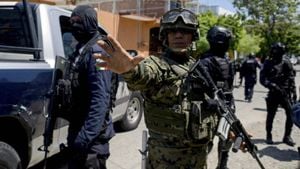TAPACHULA, Mexico — Approximately 1,500 migrants have banded together to form a new caravan as they set out from southern Mexico, with aspirations of reaching the U.S. border before the upcoming presidential inauguration on January 20. Most of these individuals hail from Central and South America, and their urgency stems from fears of heightened challenges once Donald Trump assumes office.
The caravan began its trek from the city of Tapachula, located near the Guatemalan border, where countless migrants find themselves stranded due to lacking the necessary permissions to move freely within Mexico. Many of them believe they must reach the United States quickly, fearing new restrictions on immigration will complicate their chances of making the crossing later.
Migrant caravans are not new; the movement first gained worldwide attention back in 2018. They provide an avenue for those who cannot afford to pay smugglers. Attempting to navigate the perilous route to the U.S. alone or in small groups frequently results in detention, deportation, or worse. By moving together, these caravans offer safety, as it's more difficult for immigration agents to detain large groups.
Nevertheless, the path forward is fraught with danger. Migrants must endure threats from drug cartels who extort fees for passage across their territories and are notorious for kidnapping and torturing migrants for ransom. With Tapachula to the nearest U.S. entry point at Matamoros being over 1,100 miles (or about 1,770 kilometers), the distance is enormous, let alone the health risks posed by the searing heat and dehydration along the way.
For families, especially those traveling with young children, this arduous trek is even more taxing. Many migrants are running on empty hopes for improved livelihoods and shouldering the weight of uncertainty. Yotzeli Peña, 23, from Venezuela, expressed her thoughts on the urgency of their mission: “It’s going to be more difficult, that's why we are going — hoping to get an appointment quicker so we can cross before he takes office. That would be easier.” While some have found temporary work or shelter, the overall situation remains dire.
This latest caravan highlights the struggle contrasting care from authorities, as U.S. government actions aim to stem such movements by enhancing online appointment systems through the CBP One app. Originally, the digital approach was available primarily to migrants located farther north, but by extending the service down to Tapachula, officials sought to manage the throng. Yet, many migrants remain skeptical, preferring to stay closer to the border where they can swiftly depart if allowed entry.
Despite these efforts to manage migration more orderly, frustration with the current system arose when migrants felt compelled to gather to improve their chances of getting appointments. Previous caravans have often disbanded or broken apart when met with resistance from Mexican authorities, who have implemented strict measures prohibiting transport options like buses and taxis from picking them up. This means arriving at different points will likely require hitchhiking or walking the length of southern Mexico.
Looking back at the largest caravans from 2018 and 2019, many participants relied on local communities offering assistance. This kind of aid, which included bus rides to border towns, sparked backlash among residents wary of migrant influxes. Recently, as caravans have diminished due to low permits and awareness of dangers, Mexican authorities have occasionally granted temporary transit permits to malleate migration flows.
It's no small feat to travel more than 1,100 miles under such conditions. The sheer determination against mounting adversity paints the picture of desperation faced by these caravans. They continue to undertake this immense challenge primarily because migrants from various countries have fewer viable pathways to establish lives elsewhere.
Looming political forces and headlines about policy changes serve as motivation for many migrants, as they wish to reach the U.S. before potential stricter regulations are imposed. Amid the ever-changing dynamics of migration, these groups persist, fueled by both hope for new beginnings and fear of imminent closures to the routes they seek.
So far, this new migrant caravan is marching forward, reiteratively proving the resolve of those seeking to change their fates against incredible odds. The coming weeks will reveal whether they can navigate the treacherous route successfully or face the continuing challenges posed by Mexican authorities unwilling to facilitate such movements. The urgent uncertainty is tightly woven with their dreams of safety, liberty, and opportunity.



